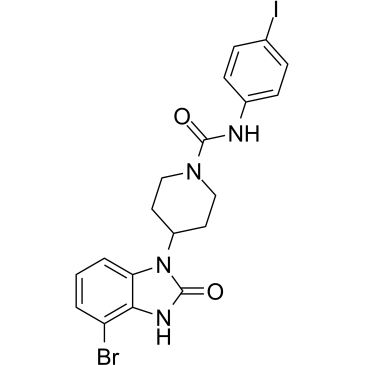TH5487 is a novel, potent and selective 8-oxoguanine DNA glycosylase 1 (OGG1) inhibitor with an IC50 of 342 nM. TH5487 inhibits DNA repair, prevents OGG1 from identifying its DNA substrate, and alters OGG1 chromatin dynamics, all of which lead to the suppression of genes involved in the proinflammatory pathway.
Physicochemical Properties
| Molecular Formula | C19H18BRIN4O2 |
| Molecular Weight | 541.180295467377 |
| Exact Mass | 539.97 |
| Elemental Analysis | C, 42.17; H, 3.35; Br, 14.76; I, 23.45; N, 10.35; O, 5.91 |
| CAS # | 2304947-71-3 |
| PubChem CID | 137321164 |
| Appearance | Light yellow to yellow solid powder |
| LogP | 3.5 |
| Hydrogen Bond Donor Count | 2 |
| Hydrogen Bond Acceptor Count | 2 |
| Rotatable Bond Count | 2 |
| Heavy Atom Count | 27 |
| Complexity | 564 |
| Defined Atom Stereocenter Count | 0 |
| InChi Key | FZLKVWWPFOLPKF-UHFFFAOYSA-N |
| InChi Code | InChI=1S/C19H18BrIN4O2/c20-15-2-1-3-16-17(15)23-19(27)25(16)14-8-10-24(11-9-14)18(26)22-13-6-4-12(21)5-7-13/h1-7,14H,8-11H2,(H,22,26)(H,23,27) |
| Chemical Name | 4-(4-bromo-2-oxo-3H-benzimidazol-1-yl)-N-(4-iodophenyl)piperidine-1-carboxamide |
| Synonyms | TH 5487; TH5487; TH-5487 |
| HS Tariff Code | 2934.99.9001 |
| Storage |
Powder-20°C 3 years 4°C 2 years In solvent -80°C 6 months -20°C 1 month |
| Shipping Condition | Room temperature (This product is stable at ambient temperature for a few days during ordinary shipping and time spent in Customs) |
Biological Activity
| Targets | OGG1 ( IC50 = 342 nM ) |
| ln Vitro | TH5487 raises the melting temperature of OGG1 in human cells. TH5487 hinders the KBrO3-induced repair of genomic 8-oxoG.In living cells, TH5487 blocks OGG1 from attaching to its genomic substrate.[1] |
| ln Vivo | In order to evaluate TH5487's potential to downregulate chemotactic (C-C and C-X-C) mediators in vivo, we subject mouse lungs to TNFα challenge and examine the expression of proinflammatory mediators in the gene expression profile. Since TH5487 works well in vivo, it may be possible to treat inflammatory diseases with this substance. [1] |
| Cell Assay |
Cell Line: Murine airway epithelial cell line (MLE 12); Diploid human small-airway epithelial cell (hSAECs) Concentration: 5 μM Incubation Time: 1 hour Result: Inhibited proinflammatory gene expression dose-dependently. |
| Animal Protocol |
mice (50% female and 50% male) of which lungs are TNFα-challenged intranasally (20 ng/ml) 30 mg/kg IP |
| References |
[1]. Small-molecule inhibitor of OGG1 suppresses proinflammatory gene expression and inflammation. Science. 2018 Nov 16;362(6416):834-839. |
Solubility Data
| Solubility (In Vitro) | DMSO: 10~25 mg/mL (18.5~46.20 mM) |
| Solubility (In Vivo) |
Solubility in Formulation 1: ≥ 2.08 mg/mL (3.84 mM) (saturation unknown) in 10% DMSO + 40% PEG300 + 5% Tween80 + 45% Saline (add these co-solvents sequentially from left to right, and one by one), clear solution. For example, if 1 mL of working solution is to be prepared, you can add 100 μL of 20.8 mg/mL clear DMSO stock solution to 400 μL PEG300 and mix evenly; then add 50 μL Tween-80 to the above solution and mix evenly; then add 450 μL normal saline to adjust the volume to 1 mL. Preparation of saline: Dissolve 0.9 g of sodium chloride in 100 mL ddH₂ O to obtain a clear solution. Solubility in Formulation 2: 5%DMSO+ Corn oil: 1.5mg/ml (2.77mM) (Please use freshly prepared in vivo formulations for optimal results.) |
| Preparing Stock Solutions | 1 mg | 5 mg | 10 mg | |
| 1 mM | 1.8478 mL | 9.2391 mL | 18.4781 mL | |
| 5 mM | 0.3696 mL | 1.8478 mL | 3.6956 mL | |
| 10 mM | 0.1848 mL | 0.9239 mL | 1.8478 mL |
